YOU ARE HERE >> AmazingRibs » Ratings & Reviews » Ratings Reviews And Buying Guides » Louisiana Grills Founders Legacy 1200 Review And Rating
Louisiana Grills Founders Legacy 1200 Review And Rating
All of our reviews are done independently by our team of testers and are in no way influenced by advertising or other monetary compensation from manufacturers. Click here to learn more about our unbiased product review process.
Published On: 10/26/2023 Last Modified: 11/8/2025
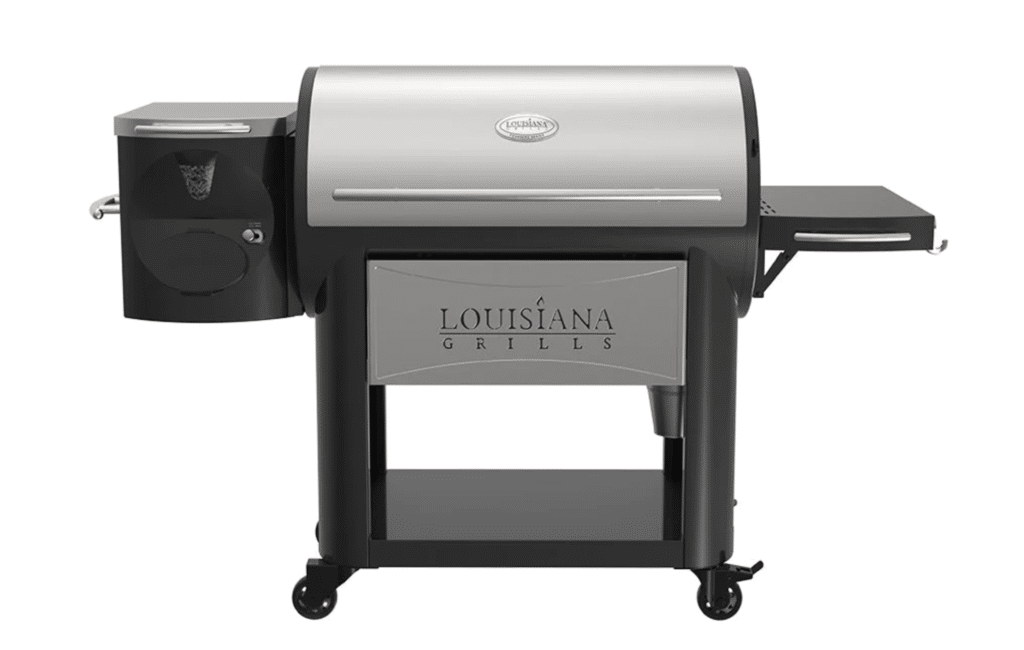
The Founders Legacy series by Louisiana Grills is the 20-year-old brand’s homage to the company’s founder and pellet cooker visionary, Dan Thiessen. Available in two models – the Founders Legacy 800 and the larger Founders Legacy 1200 – are, according to the company, “designed to raise the standard of your backyard culinary experience, beautifully combining the legacy of pellet grilling with the technology of today.”
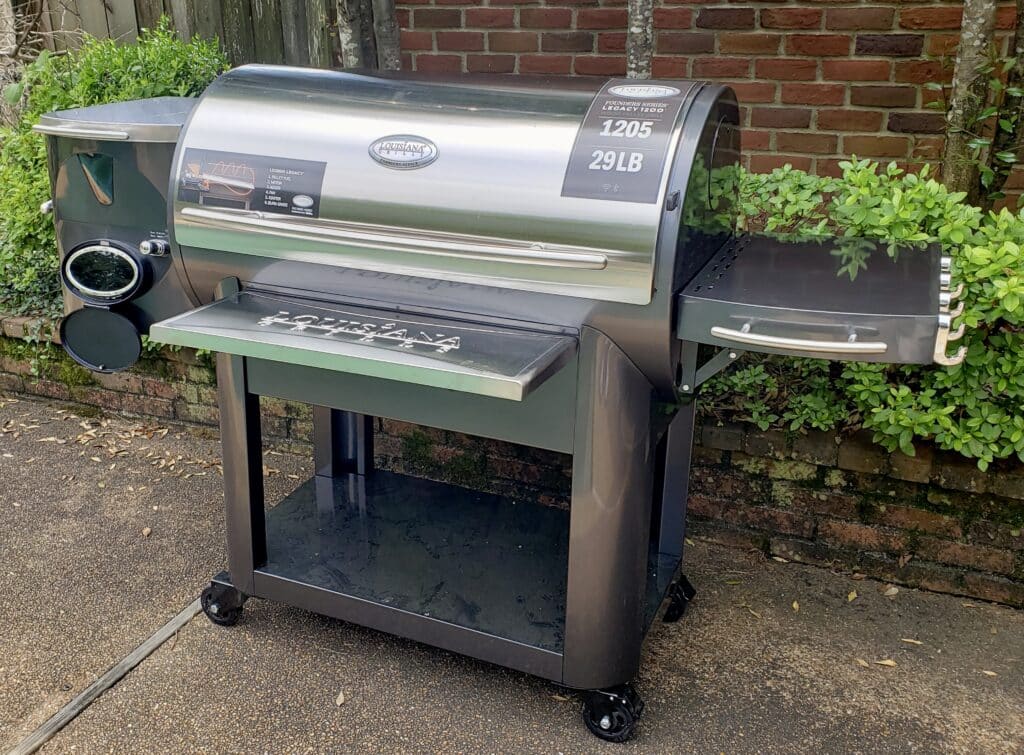

Features
While the heavy-duty construction and beautiful stainless-steel design immediately set it apart, the true differentiator for these two units is its SearTech technology that allows for both direct and indirect cooking. Most pellet smokers aren’t able to cook at high enough heat for searing, but the Founders Series nails it. A simple slide of a lever opens a series of vents above the firepot and almost instantly cranks up the heat in that left one-third section of the cooker’s main cooking grate, allowing you to go from low-and-slow smoking to hot-and-fast grilling in minutes. We’ve seen these sliding drip pan designs before and have been unimpressed until now. SearTech works as advertised. In fact, the company states that you can cook anywhere between 180°F to 600°F.
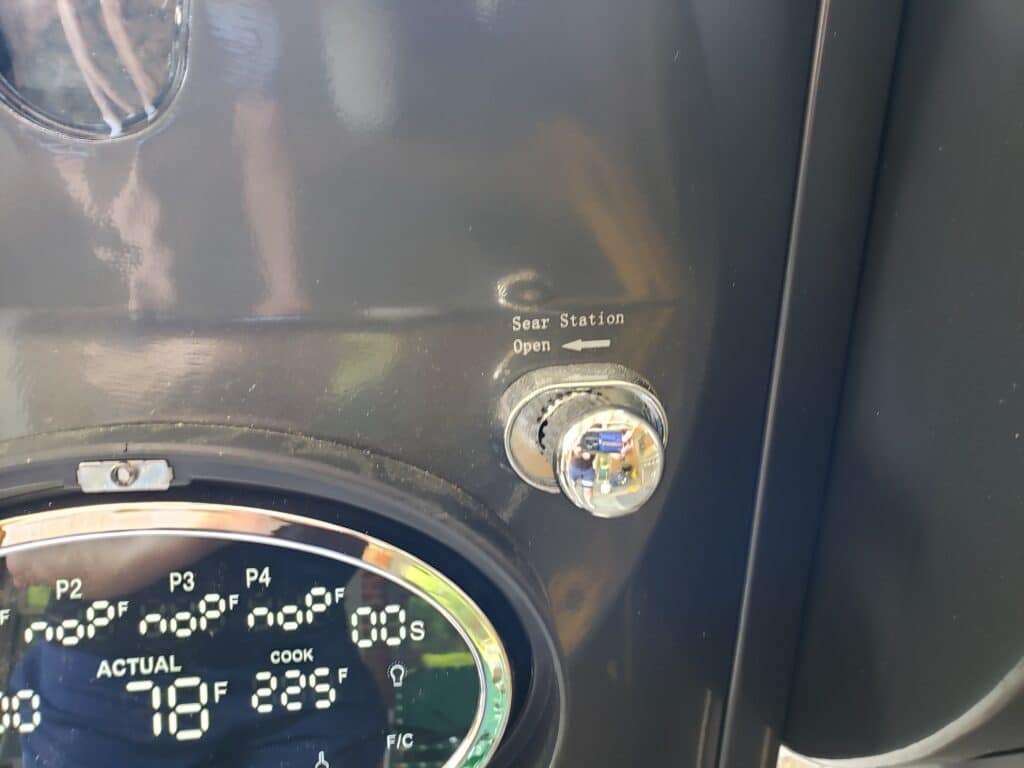
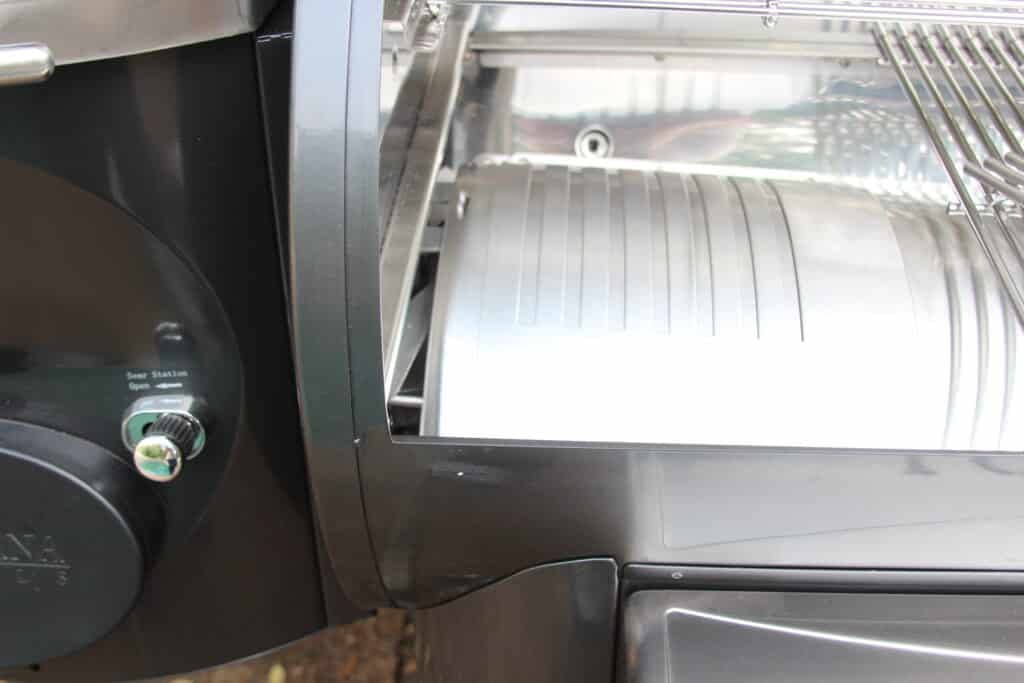
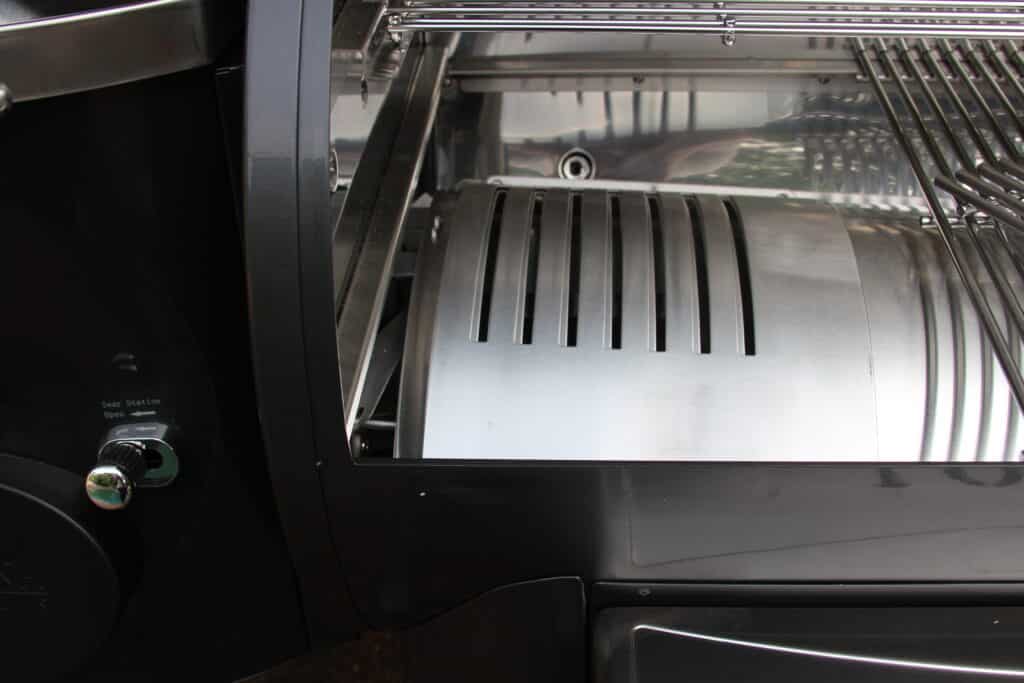
Also unique to these units is Louisiana Grills’ patented Pressurized Cooking System which features an adjustable rear exhaust system that circulates heat and smoke evenly throughout the cooking chamber.
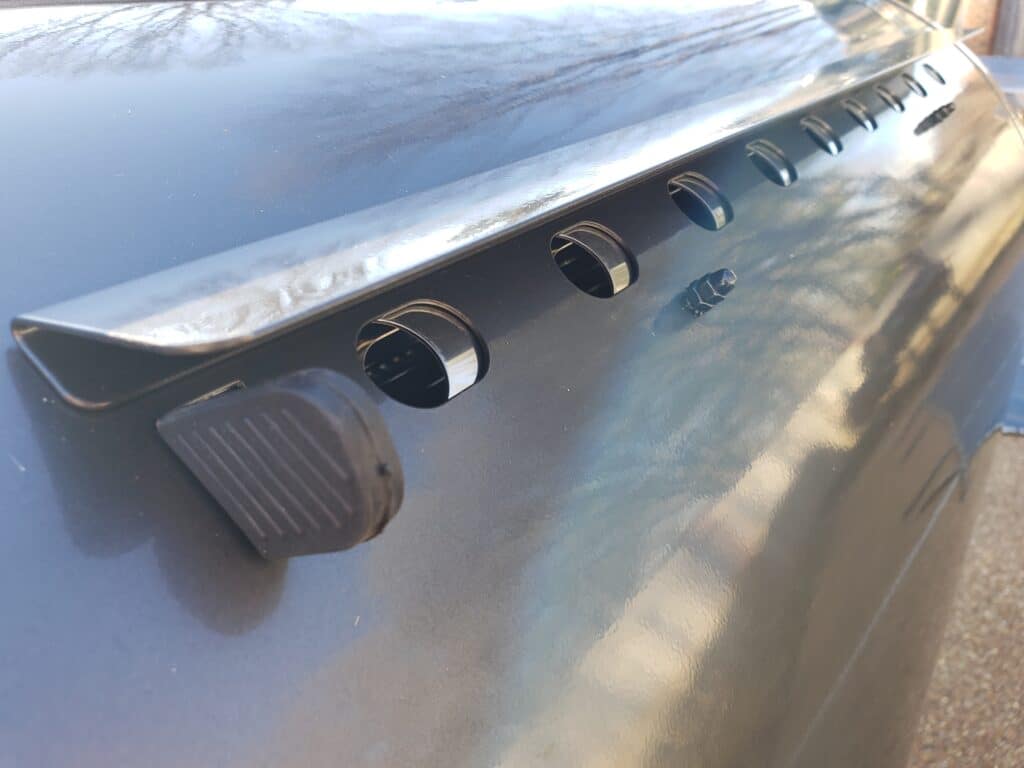
Like what you’re reading? Click here to get Smoke Signals, our free monthly email that tells you about new articles, recipes, product reviews, science, myth-busting, and more. Be Amazing!
Construction
Back to its construction, the Founders Legacy Series is built with 304 stainless steel, including a double-lined steel lid. The unit we tested — the Legacy 1200 — featured a 22-inch main body with a 29-pound pellet hopper on the left; collapsible front and right-side stainless-steel shelves (the side one also features four tool hooks and a towel bar); a digital touch screen with Wi-Fi and Bluetooth compatibility; and a large solid steel bottom storage shelf.
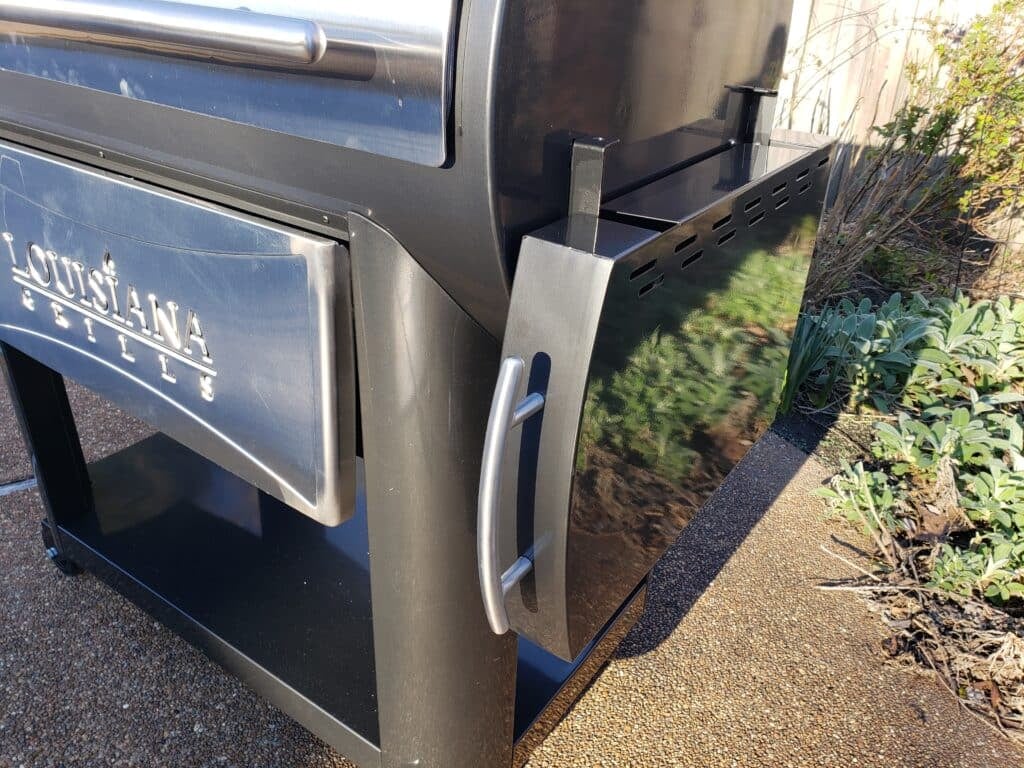
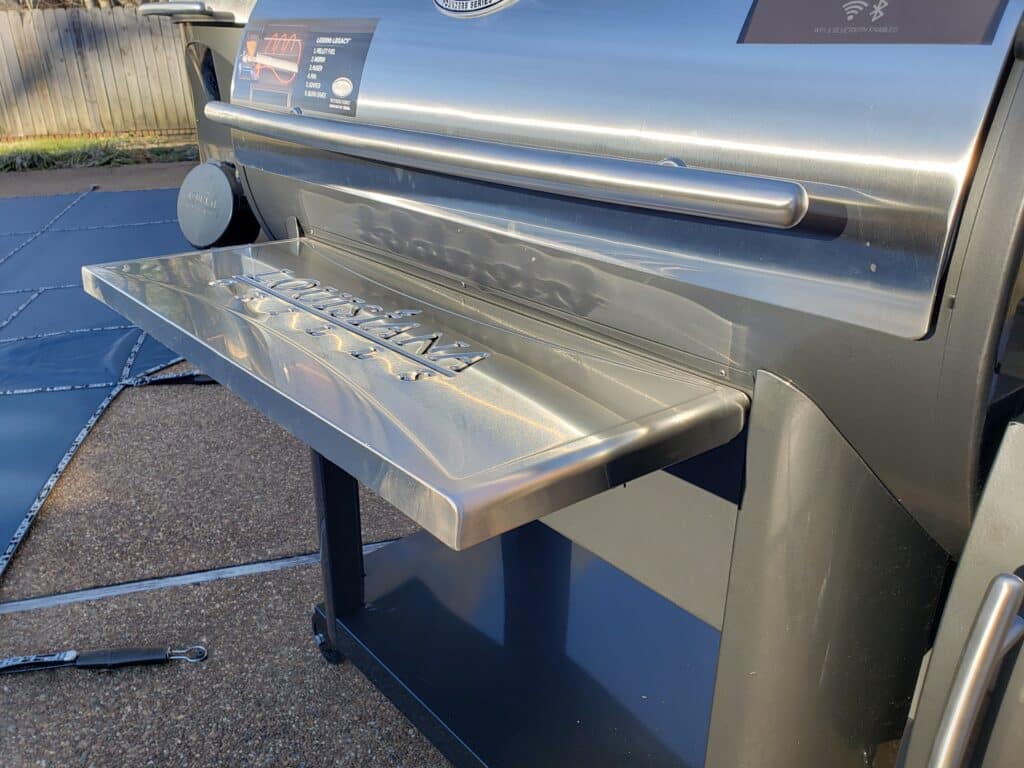
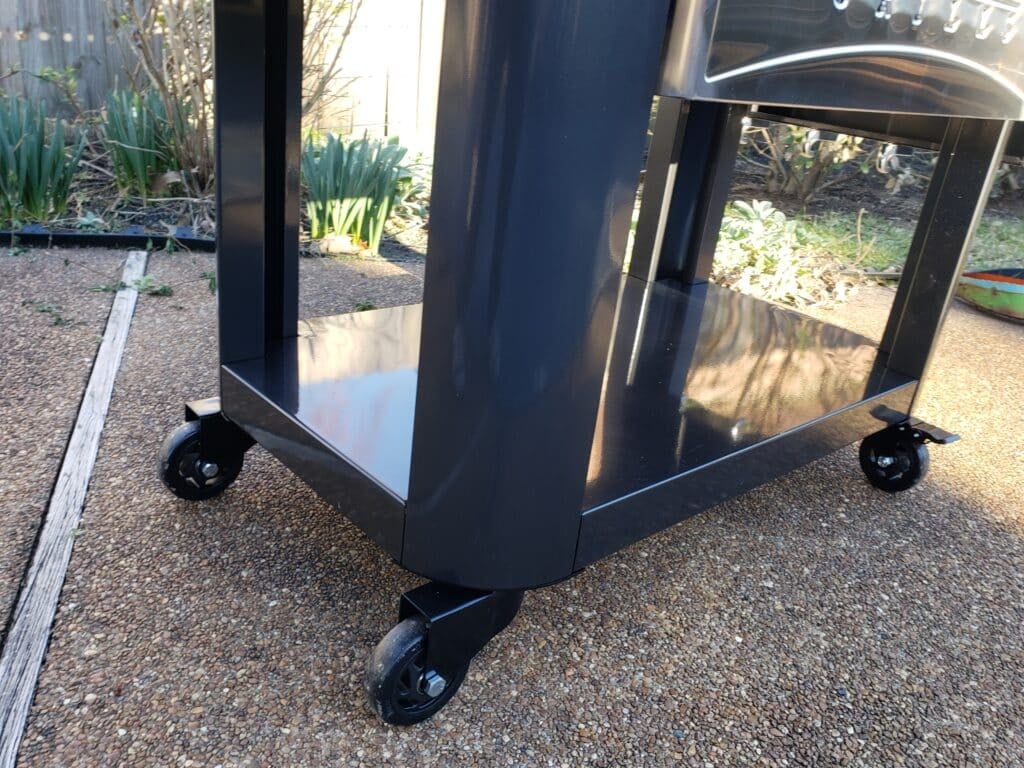
Other unique features include a front window for the hopper so you can see the level of the pellets (though you could also simply lift the lid), a rear chute for emptying the hopper of pellets (which I will admit I stupidly decided to play around with without putting a bucket beneath it, thus resulting in pellets all over my deck!), a built-in interior light, three stainless steel cooking grates, an included griddle plate that replaces the grate directly above the left sear zone, an upper cooking/warming rack, four caster wheels, and two included temperature probes.
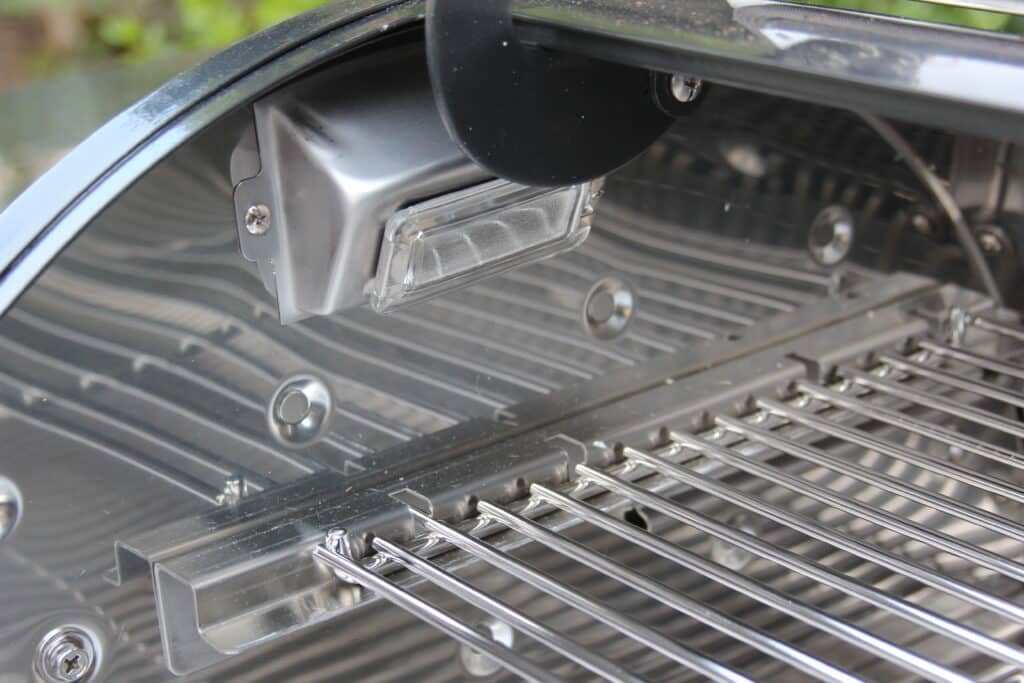
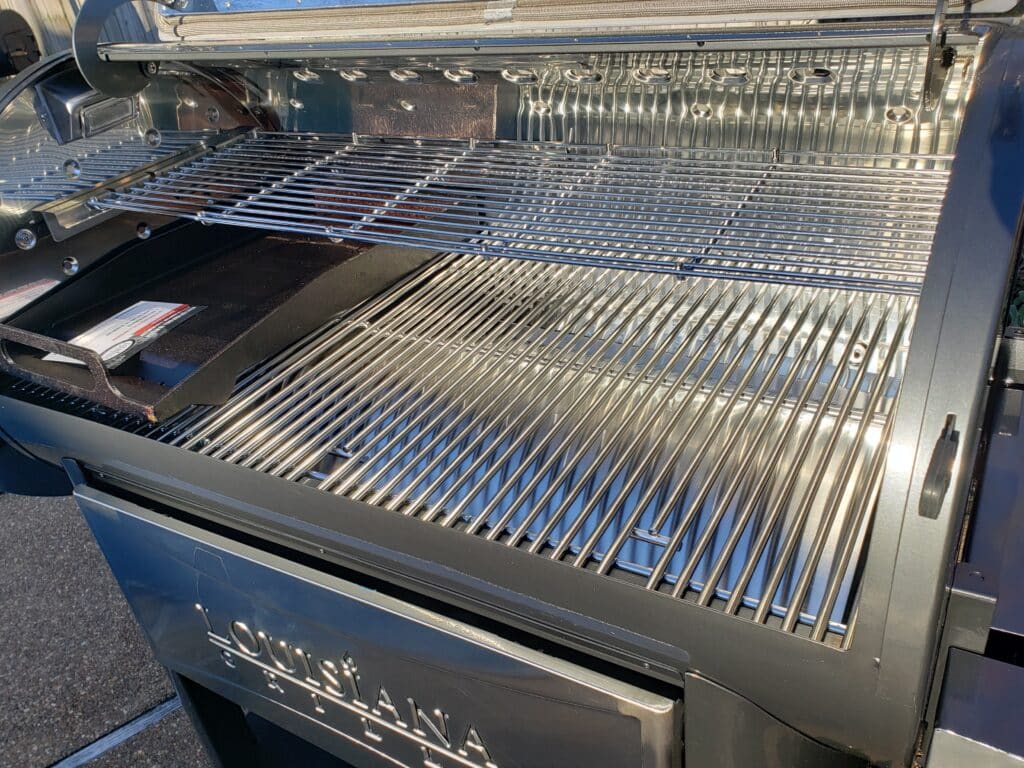
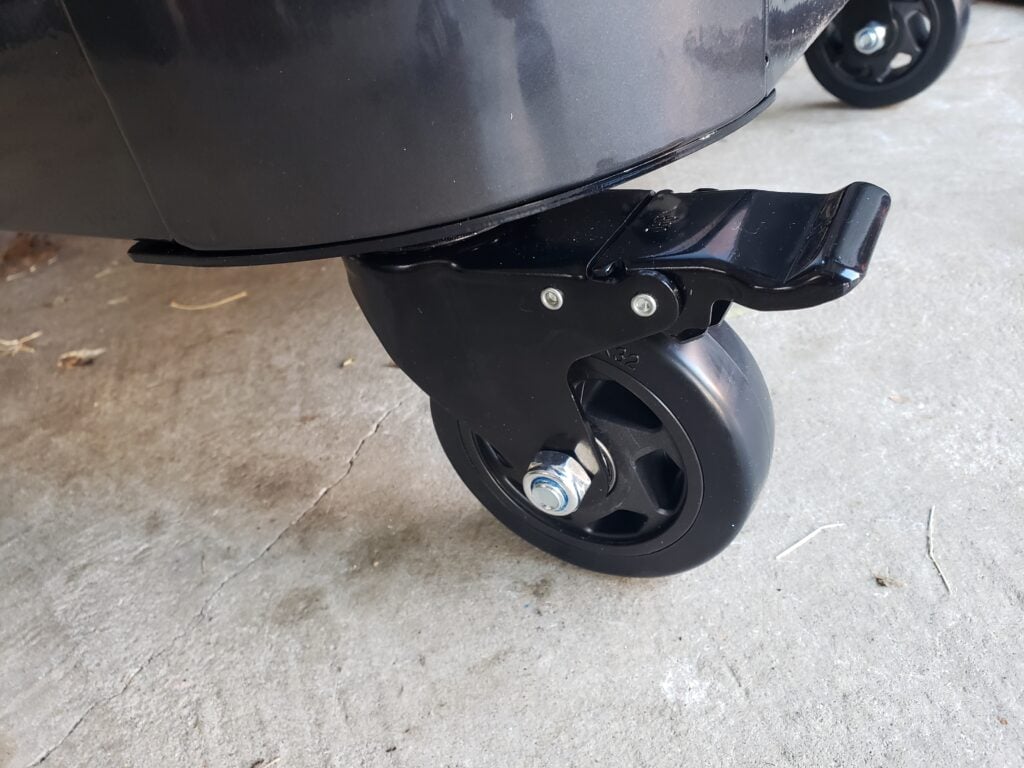
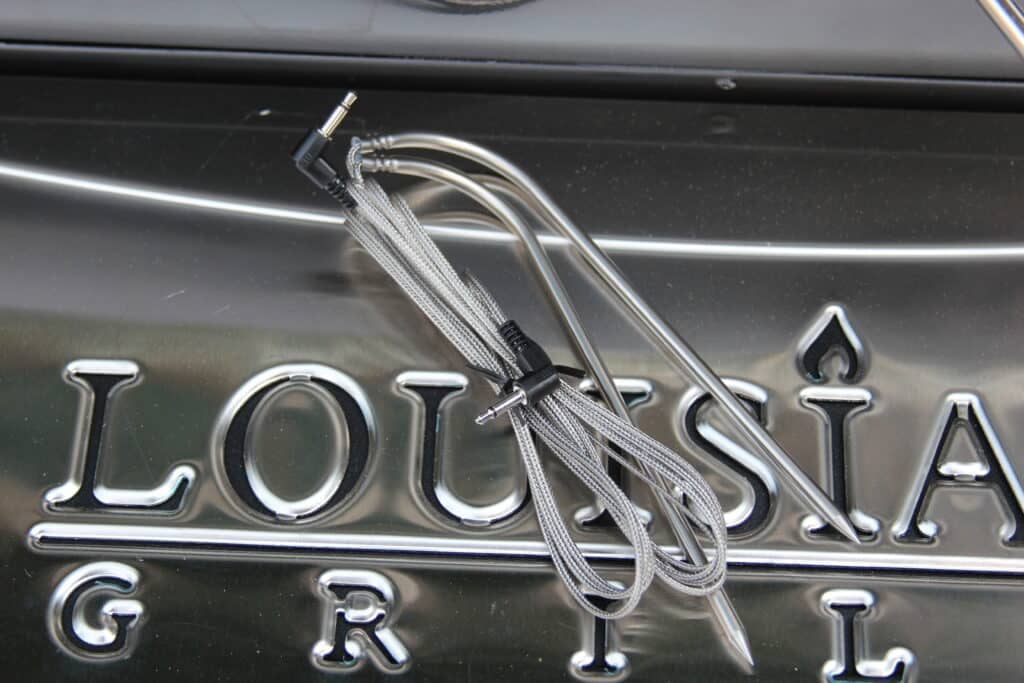
Up your game: Join our Pitmaster Club. Try it out for free for 30 days. No credit card is needed. No spam. Join now and Be Amazing!
Assembly
The 304.2-pound Legacy 1200 is extremely simple to assemble given the fact that the primary cooking chamber and attached pellet hopper come put together. Once out of the box, you and an assistant set the unit upright with the right side of the cooking chamber on the ground and the hopper on the top. You then attach the legs, followed by the bottom shelf and the casters. You then turn the cooker upright,add then handles to the side of the hopper, the lid of the hopper, and the cooking chamber’s lid. The front shelf attaches using two tabs that you insert into holes in the main body.
Design and Assembly Issues
The side shelf also attaches using two tabs, a design issue that bothered me from the jump as every time you try to raise or lower the shelf (something that has to be done in order for the cover I purchased separately to fit), the heavy-duty shelf pops out of the two tab holes and falls to the ground.
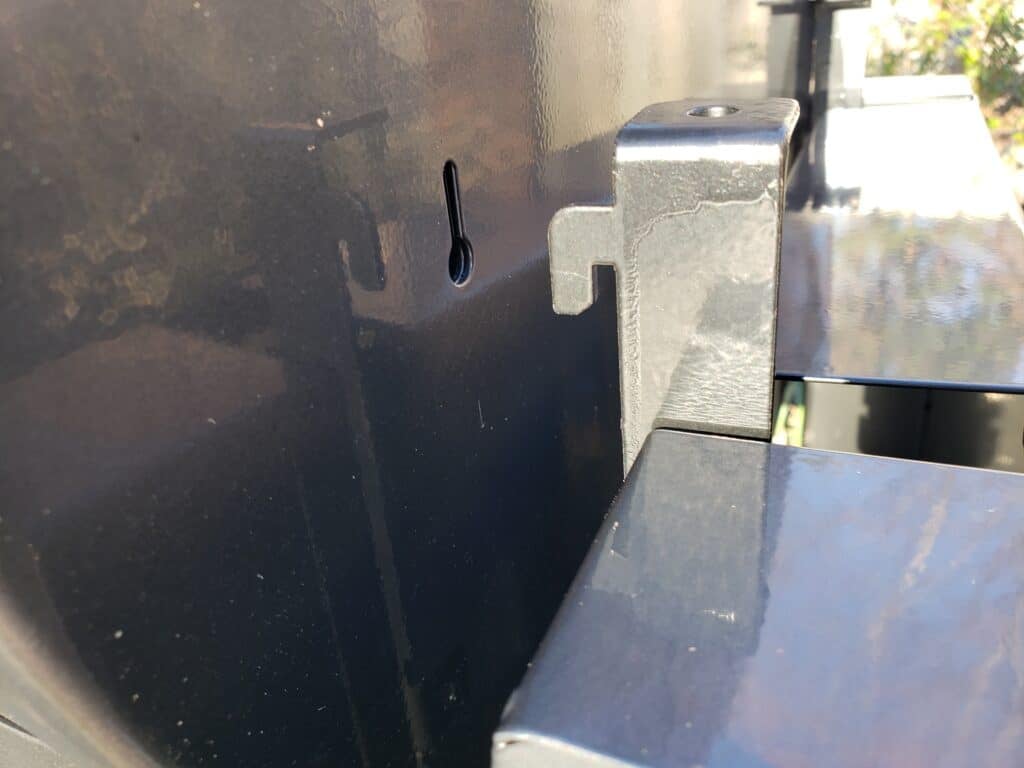
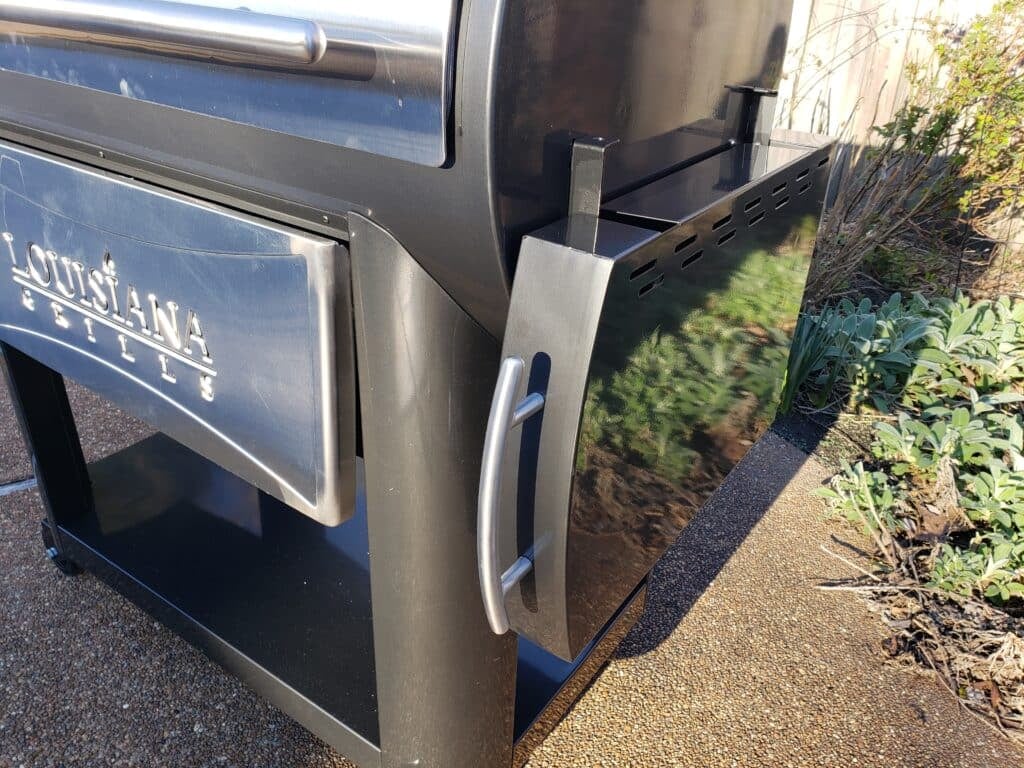
On the first two occasions, it bent the tabs in the process of falling, thus requiring me to bend them back before I could reinsert the shelf. This design flaw could easily have been remedied by adding two screw holes to the main body, allowing the arms of the shelf to be permanently affixed to the unit beyond the two easy in (and easy out) tabs. I did bring this to the brand’s attention so hopefully, it is remedied in future versions of the cooker.
But I digress. Getting back to the assembly, next comes the interior parts. I put the burn grate in place, followed by the large flame broil main plate, flame broiler slider (see the main plate topped by the flamer broiler slider plate pictured below), three primary cooking grates (or two grates and griddle insert), and upper cooking rack.
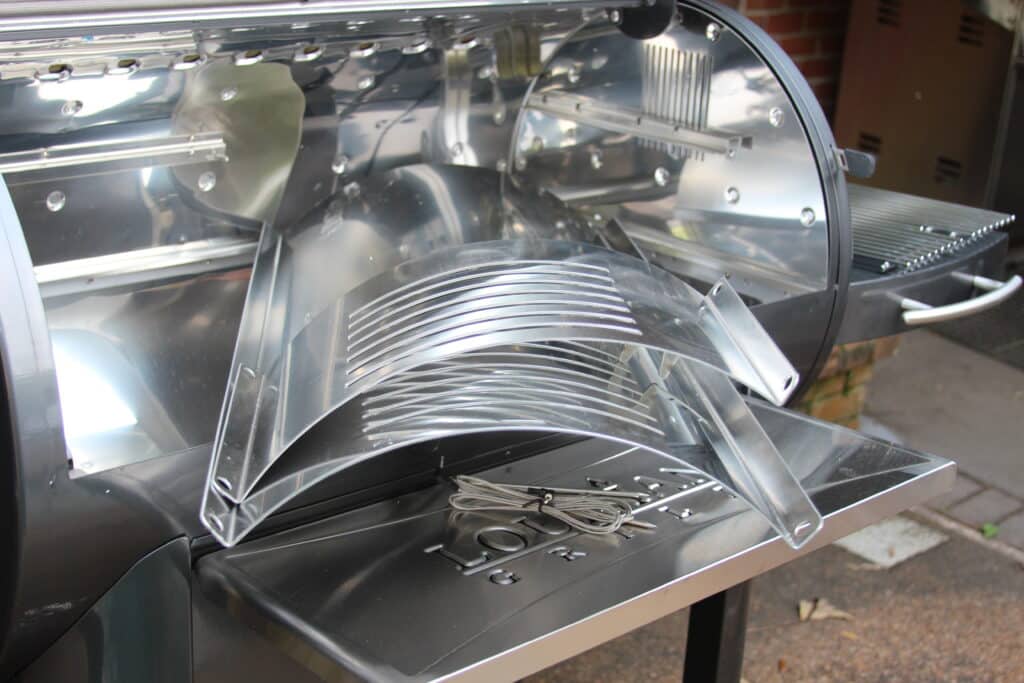
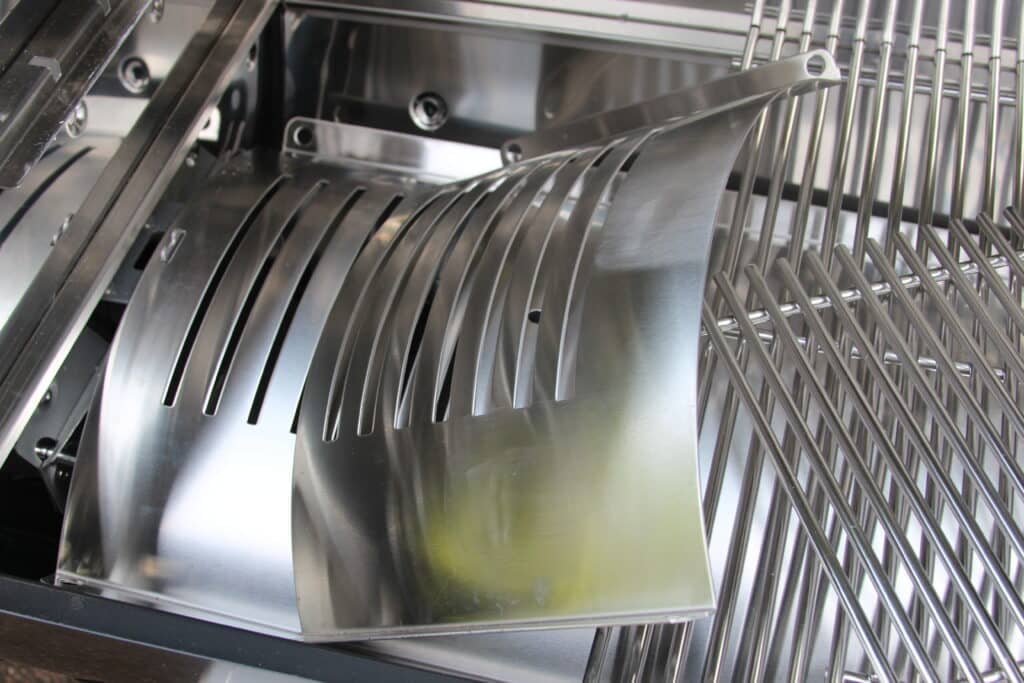
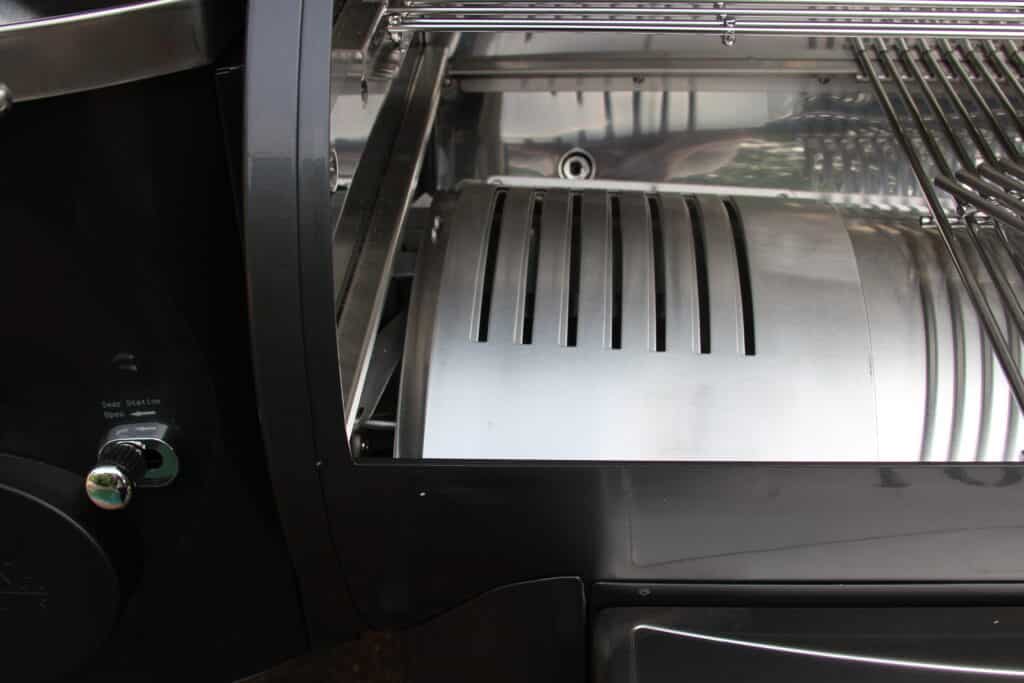
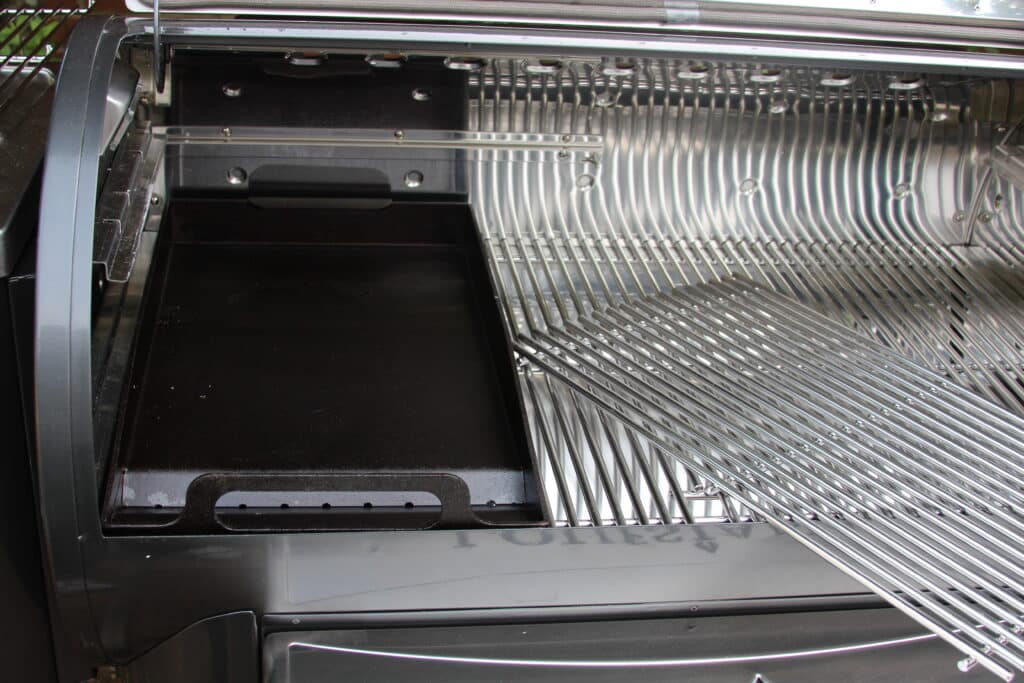
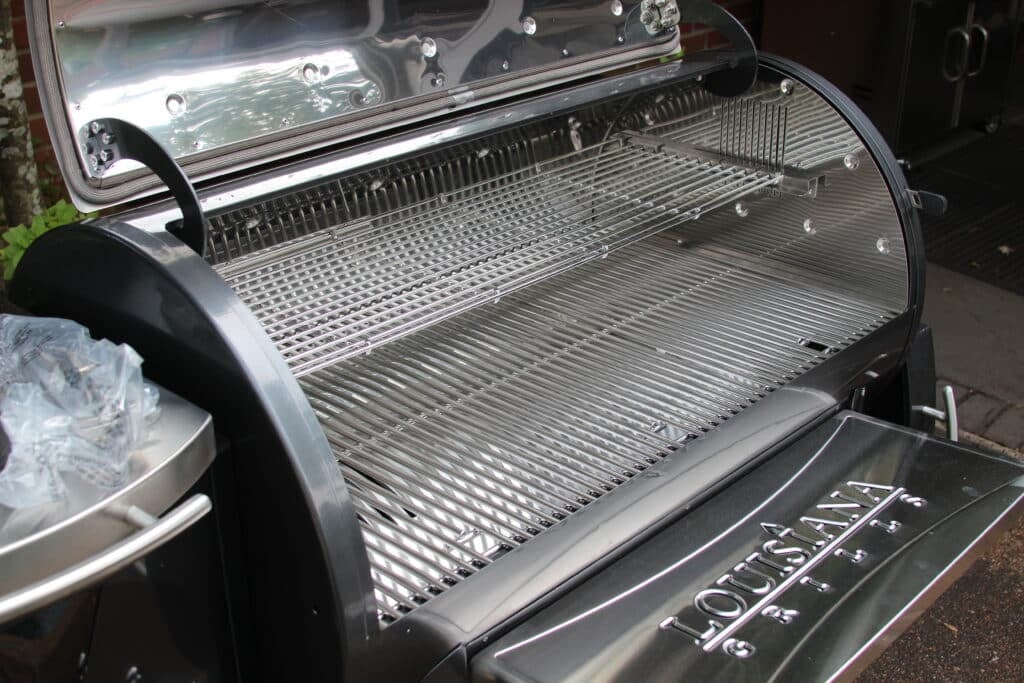
Put the grease bucket on the spout hook on the bottom of the main unit (seen below along with the front towel rack and built-in tool hooks), add pellets, and you are ready to get cooking!
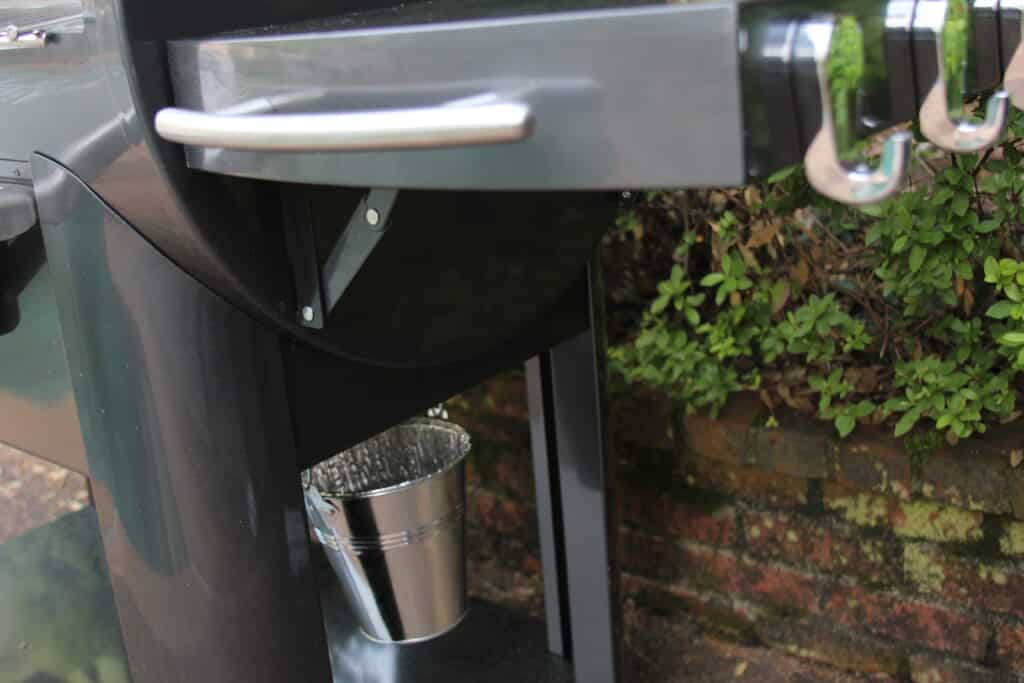
Want a new set of tools? Check out Meathead’s new book, The Meathead Method. It’s a toolbox that will elevate all your cooking. Alton Brown calls it “The only book on outdoor cookery you’ll ever need.”
Firing it up
Once fully assembled, the manufacturer instructs the user to conduct a “burn-off” before using it for the first time. To do so, you simply heat the unit to 350°F and let it run with the lid closed for 30 to 40 minutes to get rid of any foreign matter.
Control board functions
The digital touchpad is an advanced P.I.D. (proportional-integral-derivative) controller that is as easy to operate as your oven. Simply set your desired temperature using the plus and minus symbols and it will automatically adjust itself based on ambient temperature.
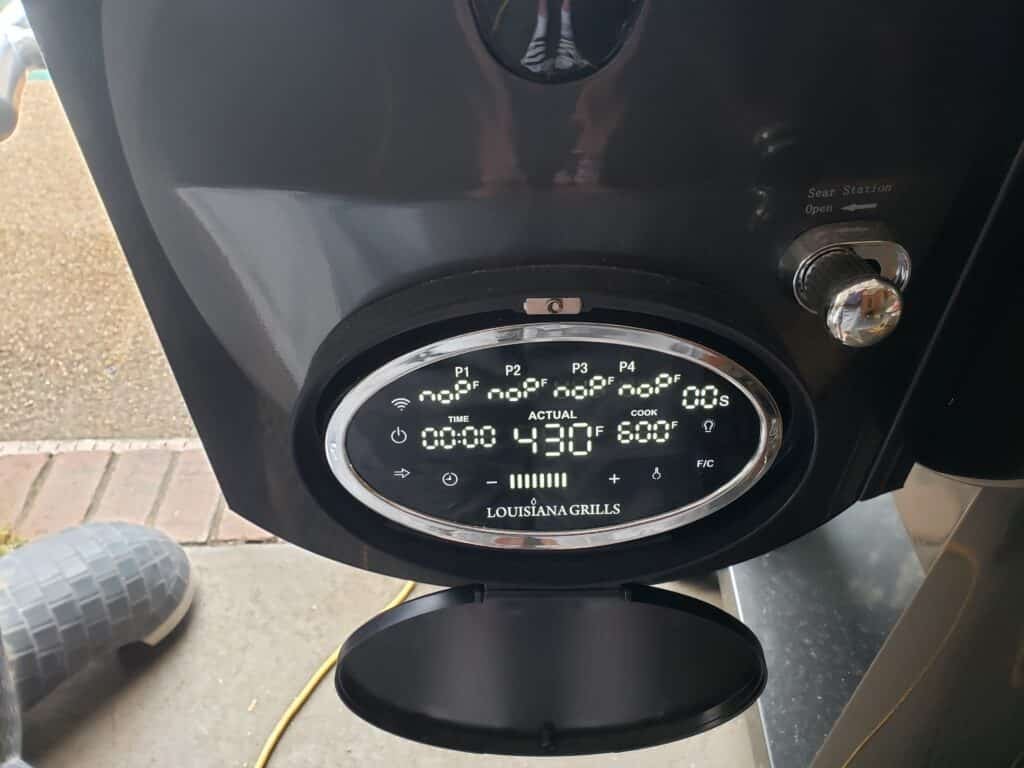
The actual temperature within the unit is based on a sensor in the main cooking barrel and is displayed on the panel as well as in the Louisiana Grills app*. There are also readouts for up to four probes as well as advanced features such as recipe settings and timers. Once you finish cooking, simply hold down the power button on the display and the unit will automatically cycle down. There is also a master switch located on the underside of the control panel which fully shuts off the power to the unit. It is worth noting that the panel also has a flip-down cover to help protect it, though it does seem a little flimsy so it will be interesting to see how it holds up, especially the hing, over time. I’ll update this when/if needed.
Note: Unless the users’ manual has been updated, it references the SmokeiT app but that app has been discontinued in favor of a Louisiana Grills’ app. The actual cooker controls can be a bit tough to find in the new app as it first opens to the Louisiana Grills’ website and then you need to locate the “grills” link at the bottom of the app/home page along with a “recipes” link and a “shop” link. Once you click on the “grills” link you can connect to your cooker via Bluetooth within a 30-foot range.
Cooking
To kick things off, I smoked a 14-pound (untrimmed) brisket at 240°F. Once the smoker came to temperature, I added the brisket to the smoker and let it cook until it reached an internal temperature of 195°F, approximately 14 hours. With the 29-pound pellet hopper, I was able to sleep all night as the brisket cooked.
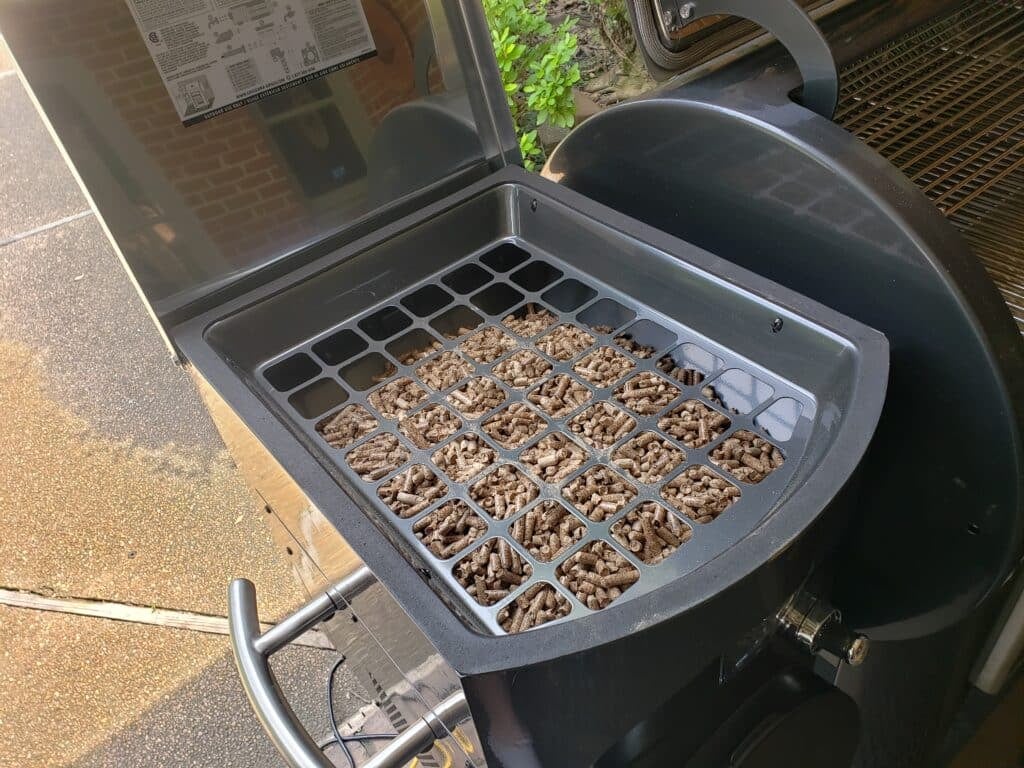
When I did sneak a quick peek before going to bed, the built-in grill light was a useful finishing touch.
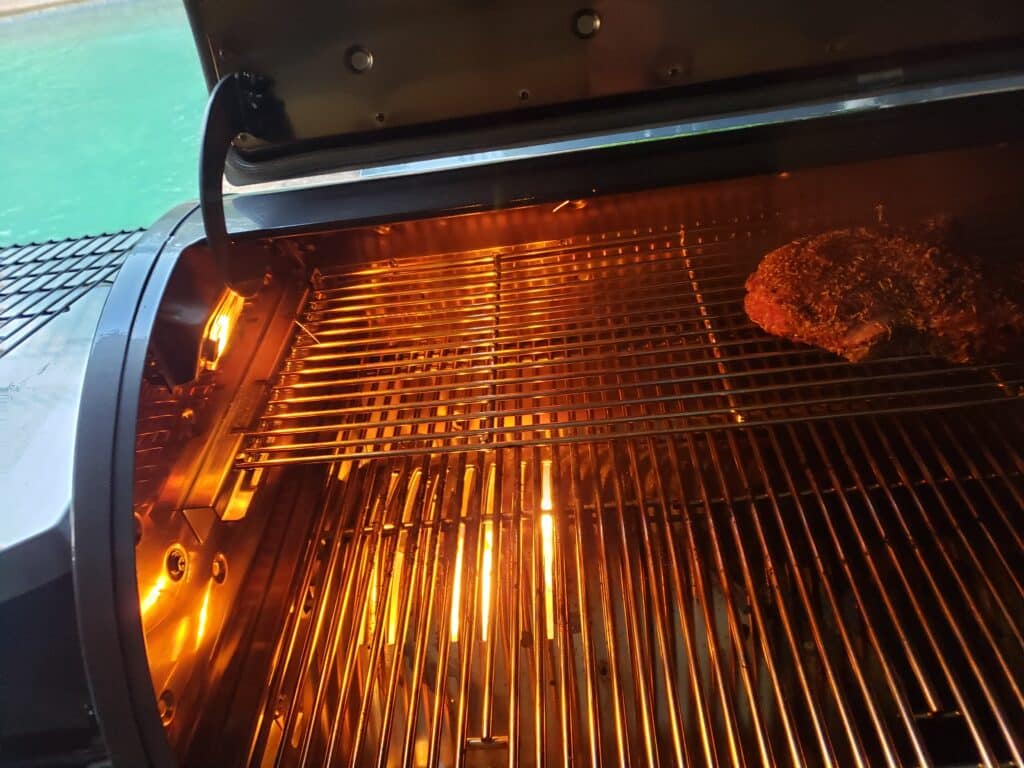
Temperature Tracking
To track the cooker’s ability to maintain a consistent temperature, I set up one probe from my Fireboard FBX 11 on the main cooking grate and charted the temp for the entire cook time. According to the data below, the overall temperature stayed in the 240°F range with only some minor fluctuations.
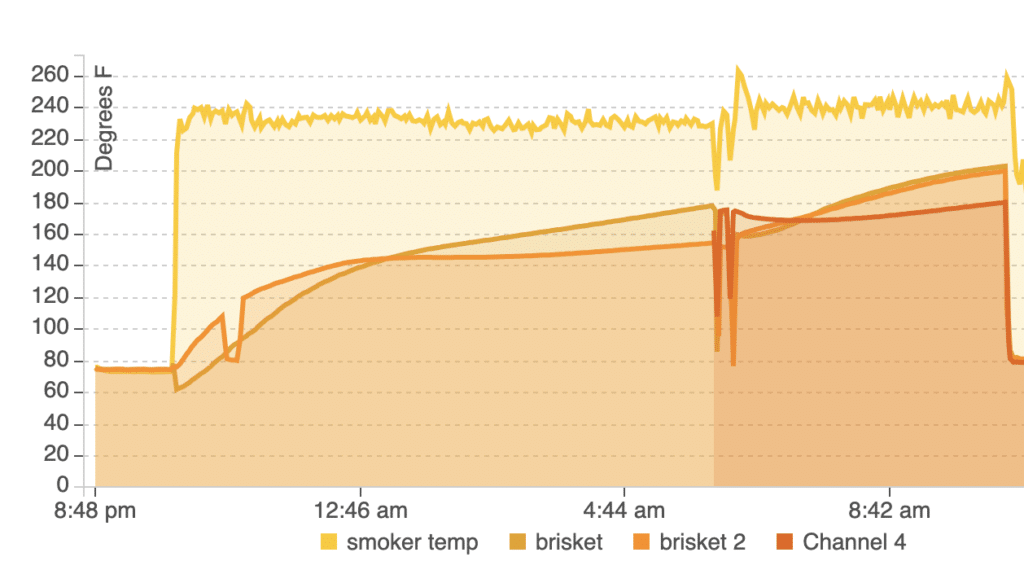
The end result was a tender, juicy brisket that despite the steady stream of pellets being fed into the firepot over 14 hours, had the perfect kiss of smoke.
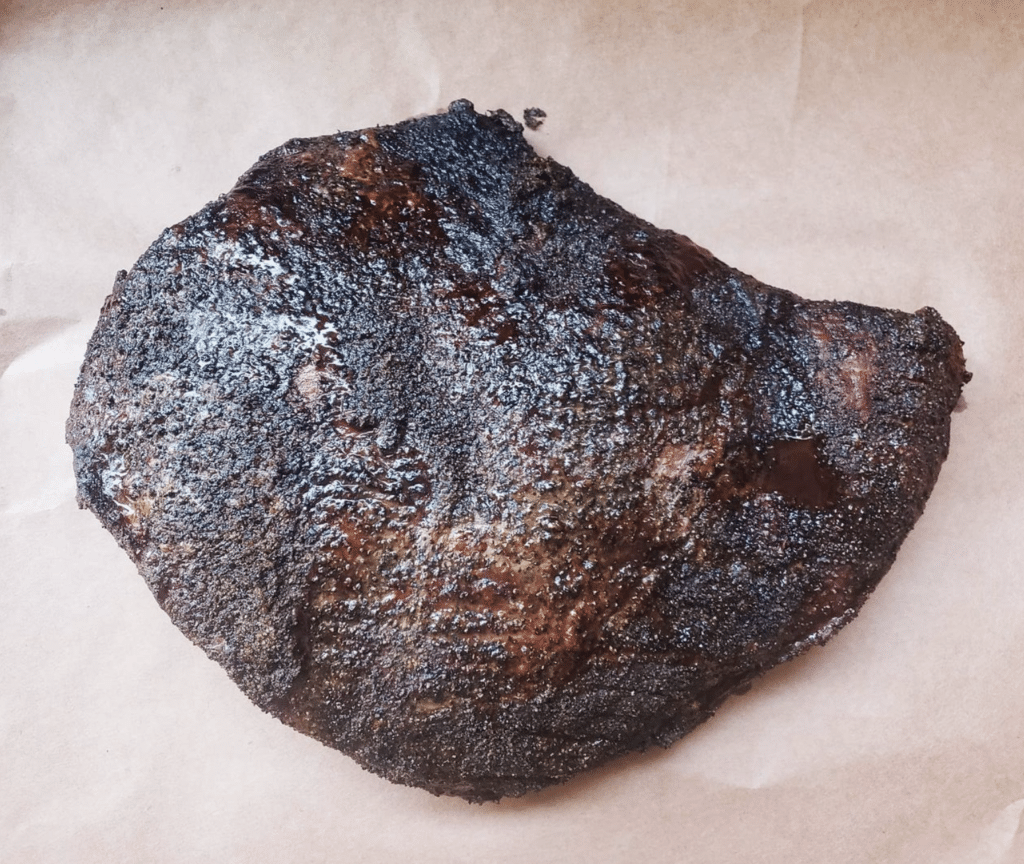
With the low-and-slow test completed, I tested the consistency of cooker temperature across the large primary cooking grate by smoking chicken wings at 350°F for approximately 30 minutes, turning them over halfway through. This resulted in perfectly cooked wings across the cooking surface with no notable hotspots.
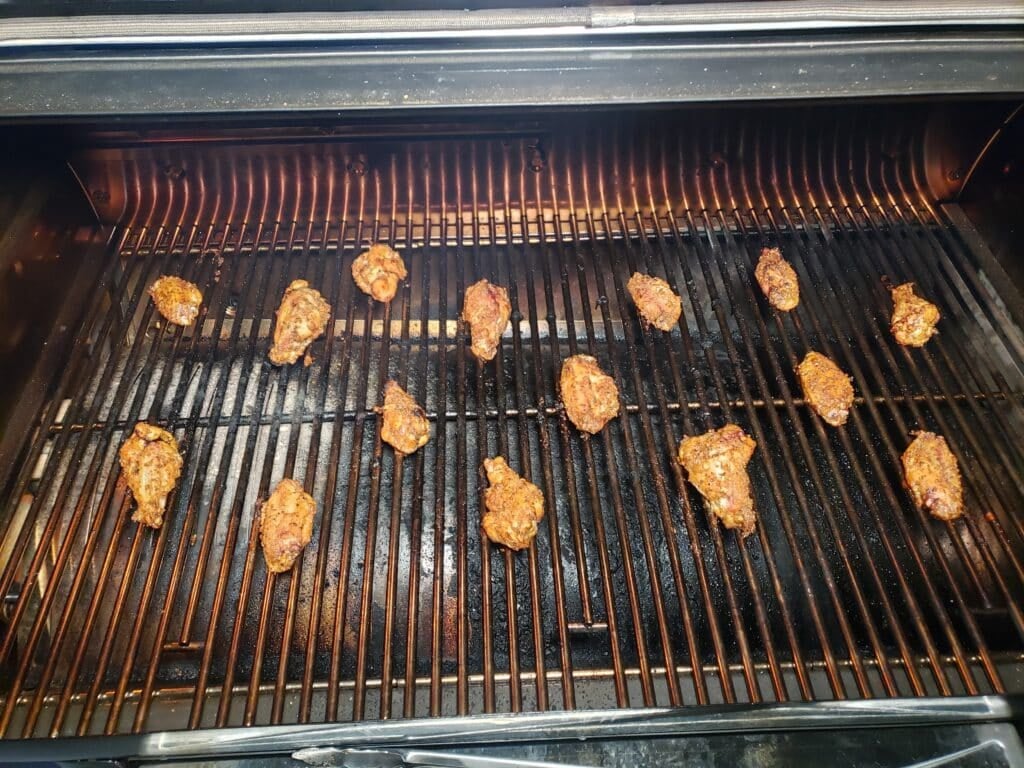
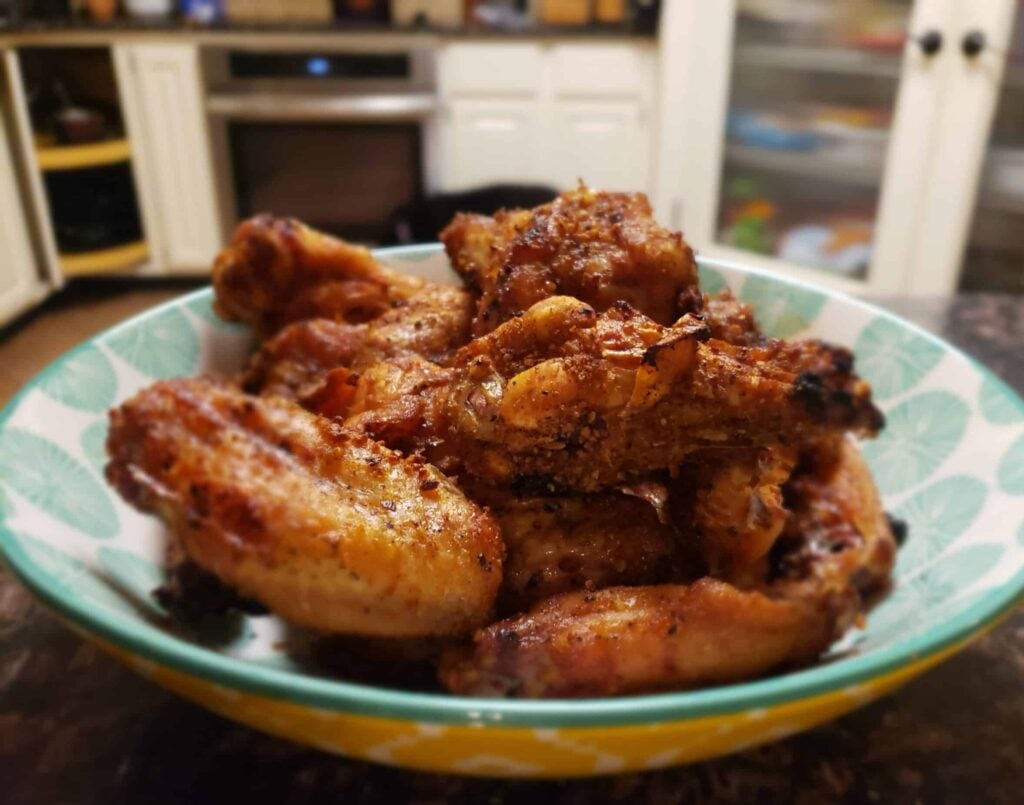
Next, I increased the temperature to 450°F and positioned slices of bread across the main grate, and let them cook for approximately 5 minutes until brown. As visible in the photo below, the bread in the center-left position was significantly darker than the other slices. This wasn’t a complete surprise as this is right above the firepot and is where the sear zone is located. There was also a darker section along the very top right side of the cooking grate which could possibly have to do with the fact that the adjustable rear exhaust was open, but this is strictly a guess. Either way, the difference was negligible compared to the zone above the firepot.
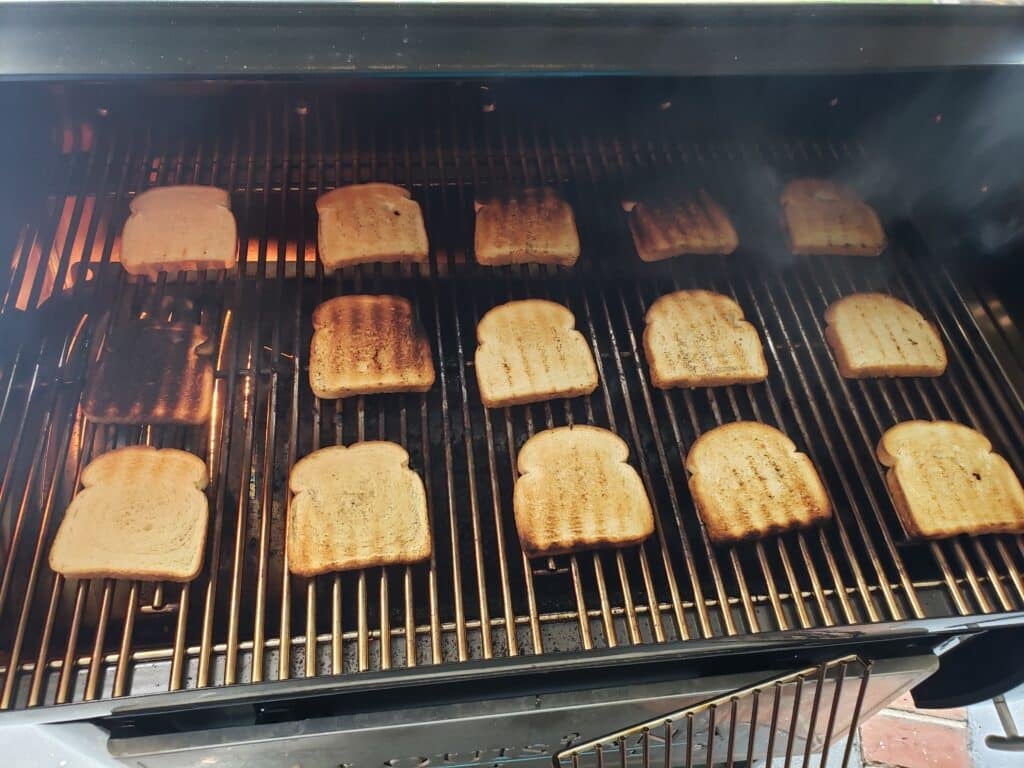
So why didn’t my wings on the left side burn like the bread? I’d have to think the lower, moderate temp of 350 was gentler than the toasting temp of 450 and is the likely explanation.
High Heat Grilling
Finally, I tested high heat grilling on the unit, taking advantage of its SearTech system which the manufacturer claims can achieve open flame searing (i.e., using the slider knob to fully open the flame broiler plate). For the test, I took a 2-inch-thick ribeye steak and cooked it using the reverse sear method which is perfectly suited for a pellet cooker with both low and high-heat cooking capabilities.
I started the steak at 225°F and allowed it to smoke until it hit an internal temperature of 119°F. I then removed the steak from the cooker and cranked the heat as high as possible (the control panel maxes out at 600°F but the temperature above the sear zone can reportedly reach 1000°F+ when the plate is in the open position. Once as hot as possible, I returned the steak to the cooker, this time right above the open flame and turned it frequently until it had formed a nice crust on both sides and the internal temperature of the steak was approximately 130°F, roughly 5 minutes later.
Editor’s note: After more than a dozen cooks using the sear zone, I noticed that the back half of the flame broiler plate began sticking when opening and closing. I’ve since taken the plates apart and cleaned off any food debris which helped but I will keep an eye on it to see if it becomes a recurring issue).
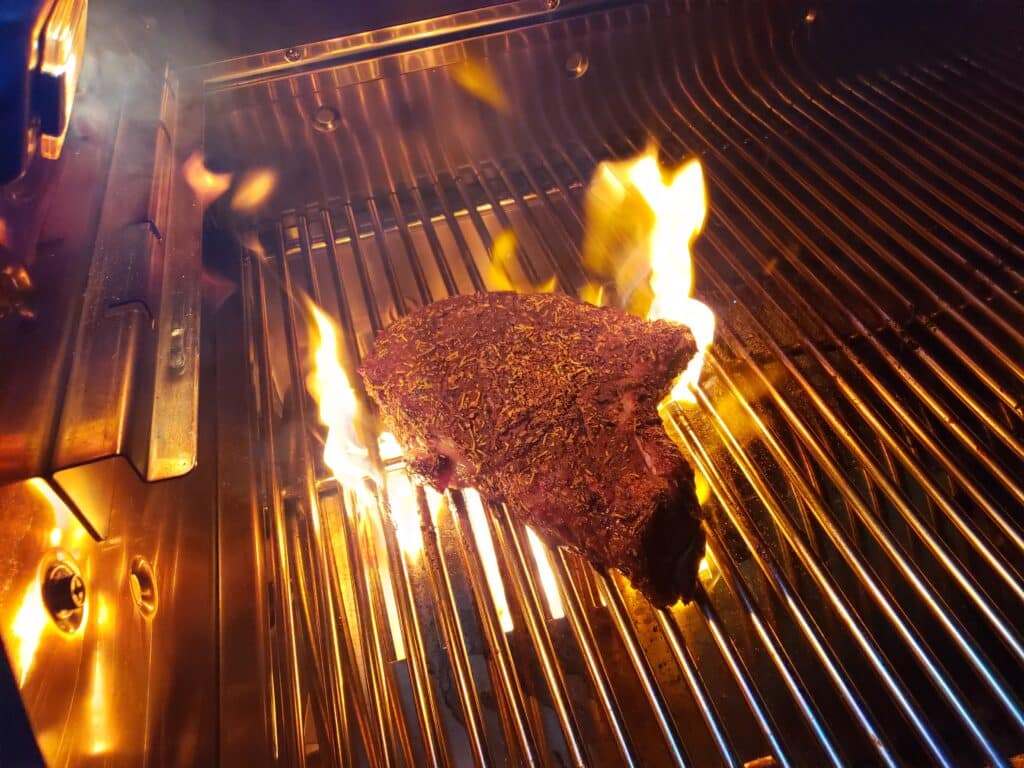
Testing Maximum Temperature
Now to really take advantage of the Founders Legacy series’ ability to achieve max temperatures well beyond most pellet cookers, I replaced the left grill grate with the included griddle insert and cranked the heat as high as I could. In fact, it was so hot (approximately 900°F according to my infrared temp gun) that the beef fat that I had rubbed the griddle surface with caught fire. Nothing temporarily closing the lid couldn’t take care of.
I did not, however, want the griddle at nearly 900°F so I turned the temperature down on the control panel and once it read 430°F, I tested the temperature of the griddle surface again. The reading was 673°F this time, a perfect temperature for smash burgers. Like the reverse seared steak, the griddled burgers turned out perfectly, though dialing in the perfect temperature takes a little practice.
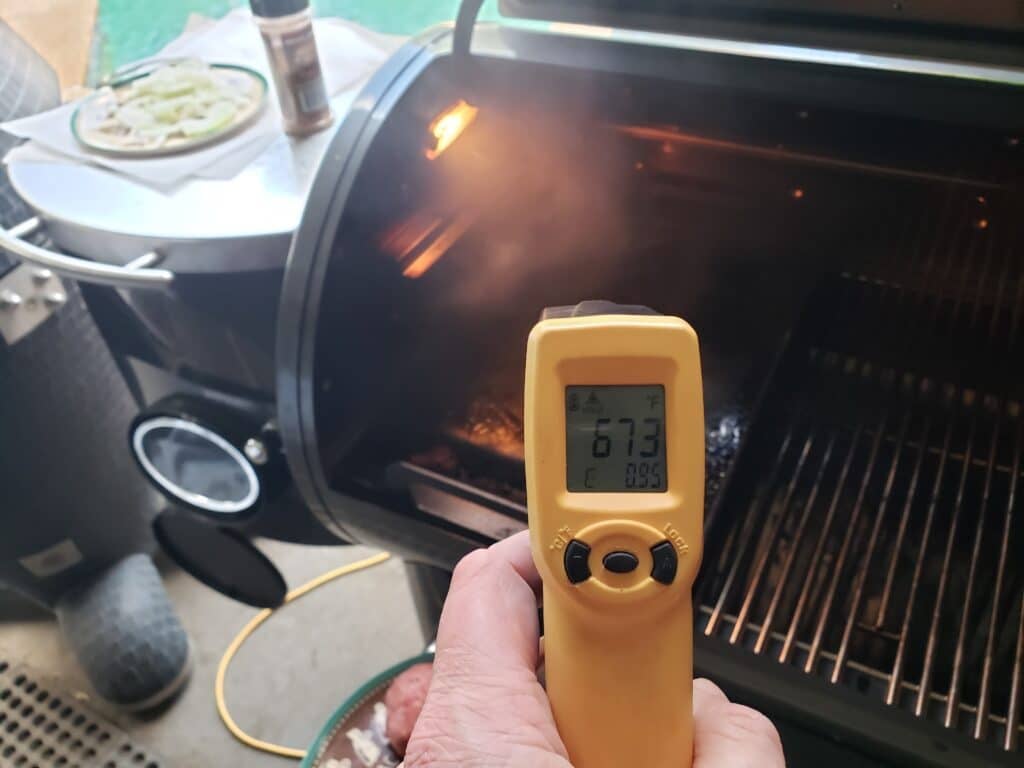
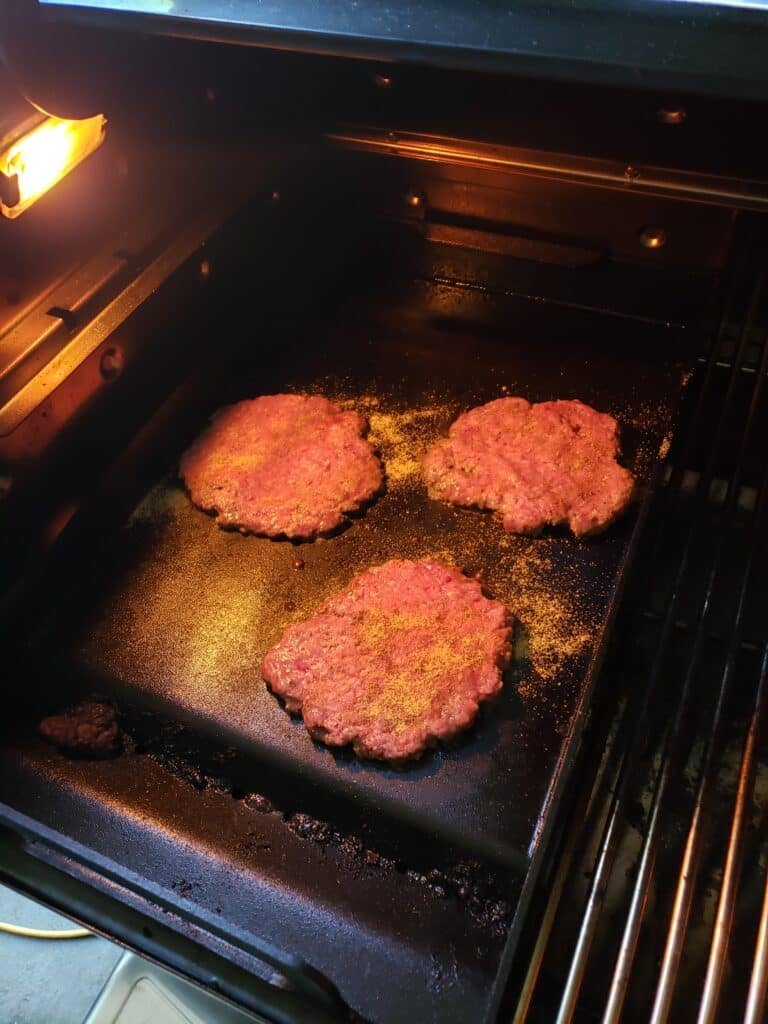
Cleanup
For regular maintenance, the stainless-steel grill grates are easy to brush off when the cooker is hot. For the burn grate (located over the burn pot) and the burn pot, the manufacturer recommends cleaning out ash with a scoop and/or shop vac. It does take some effort to get to this ash as you must remove the grill grates, the flame broiler slider, the flame broiler main plate, and the burn grate. I personally did not find there to be enough ash to warrant cleaning it out after just two cooks but you also don’t want it to hinder the proper function of the burn pot by allowing it to build up. It would also be nice if there was a way in the future to clean out the ash without having to remove so many parts.
You will also want to check the grease bucket every few cooks to avoid it overfilling and pouring out on your deck or lawn.
The manufacturer recommends cleaning it out every 15 days with a scrub pad and soapy water, though they do also sell disposable aluminum inserts for the bucket. You can wipe the outside of the unit clean. I also bought a cover from the manufacturer’s website so it stays fairly clean, and you can spruce up the stainless-steel components every so often with stainless-steel cleaner when the unit is cool.
Conclusion
All said, beyond my continuing issue with the mounting of the side table (something that hopefully will be remedied in future units by the addition of two screw holes in the main body for securing the table’s arms) there is little not to love about this unit. This includes its heavy-duty construction; the attention to small details like the included griddle insert; its ease of use; and more. But by far the standout benefit of this cooker is its high heat searing capability, something that nearly every pellet cooker manufacturer has struggled mightily with. Not only is the Founders Legacy cooker capable of searing steaks, it exceeds the maximum temperature of many gas grills when it employs the SearTech functionality. As such, we have awarded this cooker our coveted Platinum Medal.
Warranty
Louisiana Grills pellet cookers come with a 5-year limited warranty covering defects and workmanship and all steel parts and 5 years on electrical components.
We thank Louisiana Grills for providing Founders Legacy 1200 Pellet Grill for our review.
Click the buttons below to search our complete database of reviews:
Product Information:
-
Model:Founder Legacy
-
Item Price :2,399.00
*Price Subject To Change -
Where to buy (buying from this supplier supports this website):
-
Review Method:Cooked On It
We have hands-on experience testing this product. We have also gathered info from the manufacturer, owners and other reliable sources. -
Primary Function:Grill, Smoker, Combination Grill and Smoker
-
Fuel:Wood Pellets
-
Primary Capacity:Large (about 59 burgers) : 1205 square inches
Manufacturer:
-
Louisiana Grills

Louisiana Grills is headquartered in Alberta, Canada. Along with Traeger, they were one of the early entrants to the pellet smoker market. Among pellet cooking enthusiasts, Louisiana is an established name with some history to it. Their Country Smokers are standard, horizontal smokers made of black, powder coated steel. They also make Colonial smokers available in black or stainless steel. Colonials look like gas grills on enclosed carts with doors and side shelves. Lastly they offer the Estate line which consists of three drop-in smoker heads for permanent installations. Colonial and Estate are in process of being upgraded.
Parent company, Dansons, also owns Kentucky Komfort animal bedding and IBT Industrial Bulk Lubricants. Louisiana Grills are available in the USA online and at a limited selection of independent hearth and patio stores.
-
Clint Cantwell, AmazingRibs.com President And BBQ Personality - Clint Cantwell is AmazingRibs.com's President, a championship competition BBQ cook, and outdoor cooking personality.
Up Your BBQ IQ By Joining The Pitmaster Club

Sign up for a free trial of the AmazingRibs.com Pitmaster Club and experience everything that the world’s largest membership-based BBQ and grilling community has to offer!

High quality websites are expensive to run. If you help us, we’ll pay you back bigtime with an ad-free experience and a lot of freebies!
Millions come to AmazingRibs.com every month for high quality tested recipes, tips on technique, science, mythbusting, product reviews, and inspiration. But it is expensive to run a website with more than 2,000 pages and we don’t have a big corporate partner to subsidize us.
Our most important source of sustenance is people who join our Pitmaster Club. But please don’t think of it as a donation. Members get MANY great benefits. We block all third-party ads, we give members free ebooks, magazines, interviews, webinars, more recipes, a monthly sweepstakes with prizes worth up to $2,000, discounts on products, and best of all a community of like-minded cooks free of flame wars. Click below to see all the benefits, take a free 30 day trial, and help keep this site alive.
Post comments and questions below
1) Please try the search box at the top of every page before you ask for help.
2) Try to post your question to the appropriate page.
3) Tell us everything we need to know to help such as the type of cooker and thermometer. Dial thermometers are often off by as much as 50°F so if you are not using a good digital thermometer we probably can’t help you with time and temp questions. Please read this article about thermometers.
4) If you are a member of the Pitmaster Club, your comments login is probably different.
5) Posts with links in them may not appear immediately.
Moderators